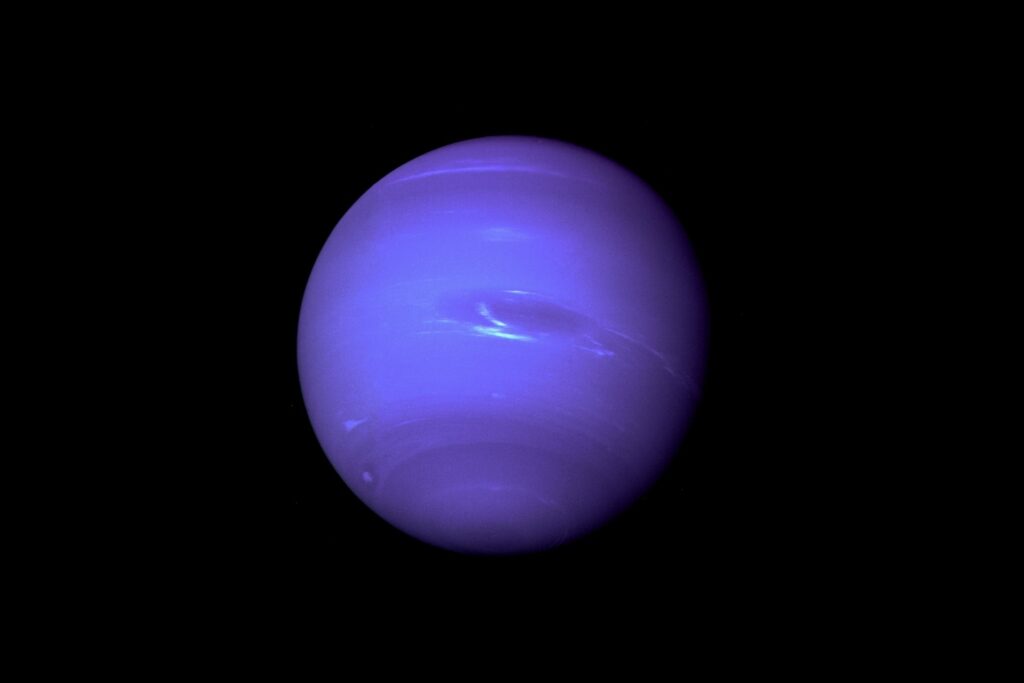Neptune is the eighth and last planet from the Sun. It is the fourth-largest planet by diameter but the third heaviest after Jupiter and Saturn. Let’s learn some interesting facts about Neptune, the “blue planet“.
Facts about Neptune (everything you need to know)
Orbit
- Neptune orbits at a distance of 2.8 billion miles (average) from the Sun. 2.8 billion miles is approximately equal to 30 Astronomical Units (AU). 1 Astronomical Unit is the average distance of Earth from the Sun. In other words, the distance of Neptune from the Sun is 30 times the distance of Earth from the Sun.
2.8 billion miles = 4.5 billion kilometers
- Neptune takes 60,190 Earth days to complete one revolution around the Sun.
1 Neptune year = 164.79 Earth years
- Neptune takes only 16 hours to complete one rotation around its axis.
1 Neptune day = 0.67 Earth days

Physical Overview of Neptune
- Water, methane, and ammonia make up more than 80% of the planet’s mass. These compounds are present in a hot, dense fluid state.
- In planetary science compounds with a melting point above 100 Kelvin are known as “ices”. Since water, methane, and ammonia have melting points above 100 kelvin, Neptune is known as an “ice giant“. The other ice giant is Uranus.
- Neptune’s upper atmosphere is mostly made up of hydrogen and helium with a small amount of methane.
- There is no true surface at Neptune. There is a small rocky core about the size of Earth.
- Neptune is about 4 times wider than Earth.
Mean radius of Neptune = 24,622 km
Mean radius of Earth = 6,371 km
- Neptune is about 17 times heavier than Earth.
Mass of Neptune = 102.413 * 10^24 kg
Mass of Earth = 5.9724 * 10^24 kg
- Neptune is the densest of all giant planets. Still, its average density is even less than one-third of Earth’s average density.
Neptune’s average density = 1,638 kg / m3
Earth’s average density = 5,514 kg / m3
Rings of Neptune
All giant planets have rings around them. There are 5 main rings of Neptune. These are named Galle, Le Verrier, Lassell, Arago, and Adams. The rings are mostly made of dust and the material is extremely dark.
Along with 5 main rings, there are 4 dust arcs named Fraternité, Égalité, Liberté, and Courage. These arcs are present in the outermost ring Adams.

Natural satellites of Neptune
There are 16 known moons of Neptune. Triton is the largest moon of Neptune. It is also the seventh-largest moon in our solar system.
Triton is the only large moon in our solar system that has a retrograde orbit. It means it orbits in the opposite direction of Neptune’s rotation.
Neptune vs Earth comparison
| Neptune | Earth | |
|---|---|---|
| Radius | 24,622 km (15,299.4 miles) | 6,371 km (3,959 miles) |
| Mass | 102.413 * 10^24 kg | 5.9724 * 10^24 kg |
| Planet type | Gas/Ice giant | Terrestrial |
| Position from the Sun | 8th | 3rd |
| Number of moons | 16 | 1 |
| Day length | around 16 hours | around 23.9 hours |
| Year length | 165 Earth years | 365.25 days |
| Time taken by sunlight to reach | around 4.1 hours | 8 minutes 20 seconds |
| Average distance from the Sun | 4.5 billion kilometers (2.8 billion miles) | 150 million kilometers (93 million miles) |
| Ring system | Yes | No |
Additional facts about Neptune
- Neptune was named after the Roman god of the seas.
- Neptune is the windiest planet in our solar system, with wind speeds exceeding 1,200 miles per hour (2,000 km/hr) in some places.
- Voyager 2 is the only spacecraft that has visited Neptune.
- Neptune’s rotational axis is tilted at an angle of 28.32 degrees with respect to its orbital axis.
Quick question
Which is the densest planet in our solar system?
Read more
Answer to quick question
Earth is the densest planet in our solar system with a mean density of 5,514 kg / m3. Mercury is the second densest with a mean